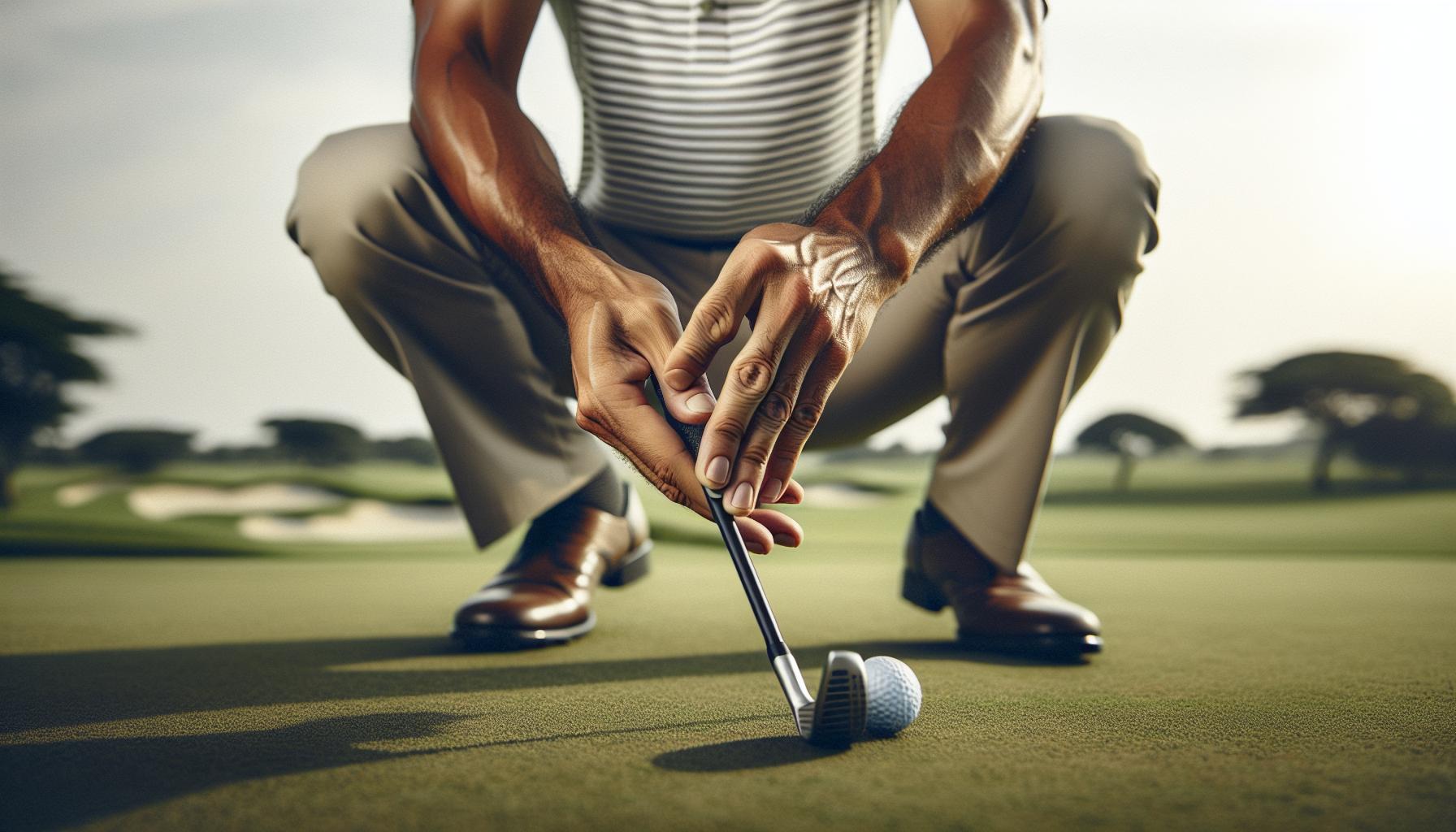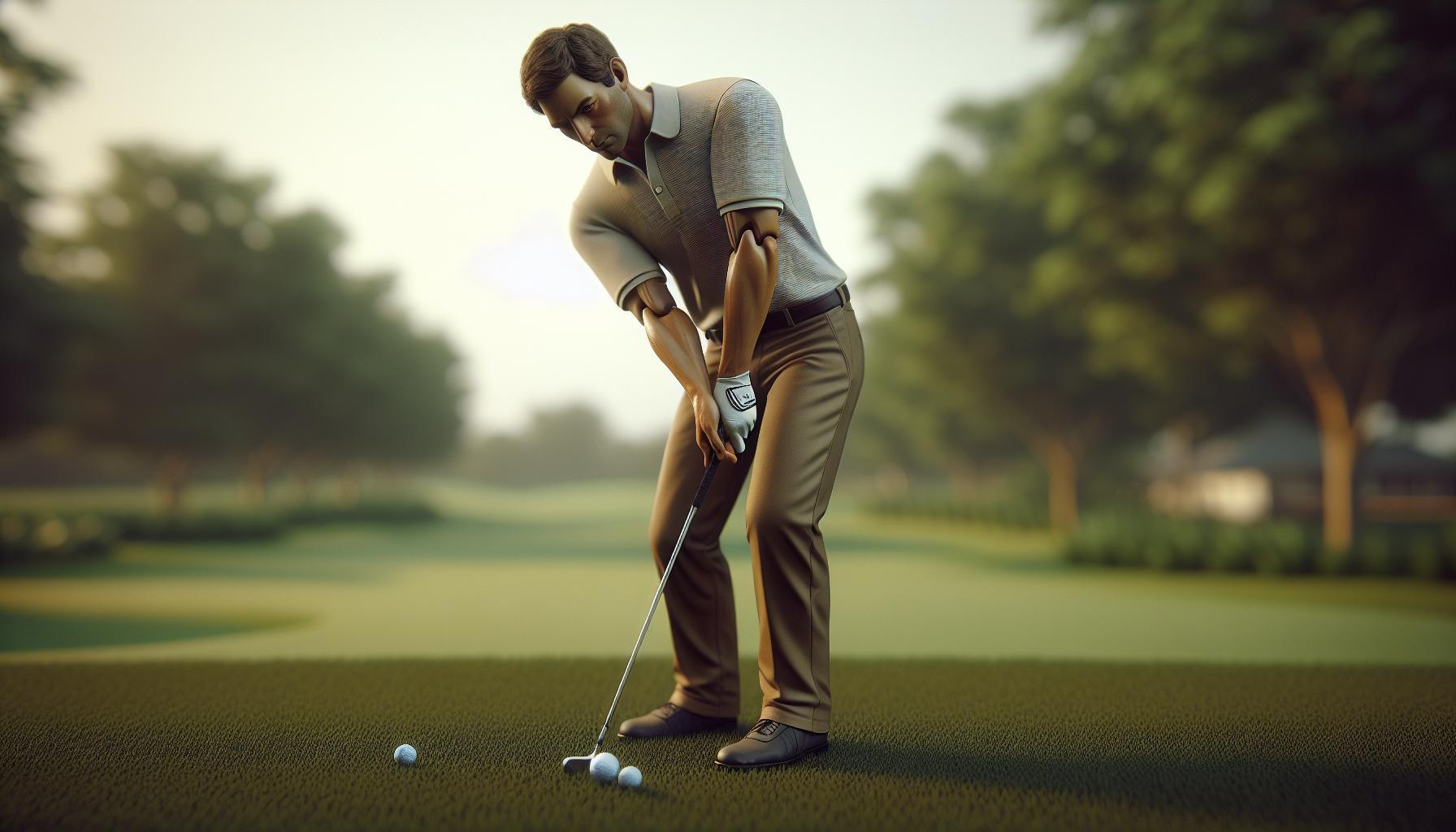Chipping is often regarded as one of the most elusive arts in golf, with many players struggling to master this critical short game skill. Did you know that nearly 30% of golf shots come from within 100 yards of the green? This crucial aspect of the game can dramatically affect your overall score and confidence on the course.
In this essential technique guide, we’ll break down the fundamentals of chipping, from stance and grip to club selection and swing mechanics. Whether you’re a beginner seeking to lower your scores or an advanced player aiming for greater precision, understanding the intricacies of chipping gives you the tools to approach every round with confidence. With the right techniques at your fingertips, you’ll transform those tricky short shots into smooth opportunities to save pars and elevate your game. Continue reading to unlock the secrets of effective chipping and start making a significant impact on your performance.
Understanding the Golf Chip Shot: What You Need to Know
When approaching the golf chip shot, understanding its fundamentals is essential for transforming short game performance. A chip shot is a delicate balance of precision and touch, requiring not only skill but also a keen awareness of the course conditions and your equipment. Unlike a full swing, chipping demands a more controlled motion, focusing on trajectory and spin to accurately navigate obstacles and set up for a successful putt.
To master the chip shot, familiarize yourself with the mechanics of how the ball interacts with the ground. A key aspect is the angle of attack; a downward strike on the ball with a lofted club will produce the necessary spin and lift to carry the ball over obstacles while allowing for a softer landing. Consider the type of grass and the firmness of the ground beneath the ball-these variables can significantly influence the outcome of your shot.
Additionally, selecting the right club is paramount. A gap wedge or sand wedge is often favored for chipping due to their loft and versatility. However, practicing with multiple clubs, including a pitching wedge or even a 9-iron, can help you learn how to control the distance and trajectory based on your position and the shot’s requirements. Developing an intuitive understanding of these dynamics will elevate your short game, enabling you to tackle various scenarios on the course with confidence.
As you practice, concentrate on the rhythm of your stroke rather than the end result. By allowing your body and the club to work in harmony, you’ll find that your ability to gauge distance and produce accurate chips will improve over time. This foundational understanding of the golf chip shot will empower you, setting the stage for more complex techniques and strategies as you continue to hone your skills.
The Anatomy of a Successful Chip: Key Techniques

The ability to execute a successful chip shot lies in understanding and mastering a few key techniques that blend precision, feel, and strategy. A chip shot is often the difference between saving par or facing the dreaded bogey, and with the right skills, it becomes a formidable weapon in your short game arsenal.
Developing a consistent rhythm is fundamental to successful chipping. To achieve this, focus on employing a pendulum-like motion with your shoulders-not your hands. This technique fosters a smoother execution, allowing for better control of the clubface’s angle at impact. Additionally, leaning slightly towards your target while maintaining a stable lower body helps in achieving a clean strike on the ball. It’s vital to ensure your weight is favorably distributed (around 60% on your front foot) to promote an effective downward strike.
Understanding the loft and bounce of your clubs can greatly improve your chipping performance. A sand wedge, for example, typically has a higher loft and more bounce, which is excellent for softer landings when you’re facing the green. Conversely, a lower-lofted club like a pitching wedge allows for a lower trajectory, which can be advantageous on tighter lies. Familiarize yourself with how different clubs react across various turf conditions, enhancing your ability to make quick decisions on the course.
Lastly, aim speaks to the heart of effective chipping. Instead of focusing solely on the hole, visualize a landing spot on the green. Calculate how the ball will roll once it hits the target area, taking into account slopes and grain of the grass. By practicing this method, you will cultivate better distance control and accuracy for your chips, allowing you to clear obstacles, land softly, and set up for an easier putt. By integrating these techniques into your practice routine, you can elevate your chipping game and improve your overall performance on the course.
Choosing the Right Equipment for Chipping

Choosing the right equipment significantly impacts your chipping performance, as the right tools can help you execute shots with precision and confidence. Understanding your options allows you to tailor your gear to meet the specific demands of your game and course conditions.
When it comes to chipping, the wedge selection is paramount. Most golfers typically carry a few different wedges, each designed for specific uses around the green. A sand wedge (usually between 54° and 58° of loft) is ideal for higher, softer shots, thanks to its design that promotes more bounce. In contrast, a pitching wedge (around 44° to 48°) offers a lower trajectory, making it advantageous in tighter lies where you need to keep the ball low and run it onto the green. Understanding the differences in loft and bounce helps in selecting the right club based on the lie and the distance to the target.
Aside from the wedges, the golf ball you choose plays an equally crucial role. Opting for a ball with a softer cover can enhance feel and control, especially on delicate chip shots. For instance, premium options like the Titleist Pro V1 or the Callaway Chrome Soft feature softer covers, allowing for better greenside performance. When selecting a golf ball, pay attention to factors such as compression ratings-lower compression balls tend to offer increased distance and a softer feel, which can benefit players looking for greater control around the greens.
It’s also worth considering the shaft flex when choosing wedges, as this can influence your shot trajectory and distance control. Standard flex might suit most amateur players, but those with faster swing speeds might benefit from a stiffer shaft for more precision. Taking the time to get fitted for your clubs can yield significant improvements in your chipping by aligning your equipment with your unique swing characteristics.
In summary, taking a thoughtful approach to equipment selection-focusing on the right wedges, golf balls, and shaft flex-can be a game-changer for your chipping. Test your options and consider how each piece of gear complements your style, giving you the edge necessary to elevate your short game.
Mastering Grip: How It Affects Your Chip

The grip is one of the most crucial elements in executing a successful chip shot. A proper grip not only helps maintain control over your club but also influences the trajectory and touch of your shot. Using the right grip pressure-where it feels secure but not overly tight-can significantly impact the feel of your shot. A relaxed grip allows for better wrist hinge and a more fluid motion, while tension can lead to jerky movements and poor contact. Striking the right balance is vital; take time to practice different grip pressures during your practice sessions to find what works best for you.
There are multiple grip styles to consider, such as the interlocking grip, overlapping grip, or the ten-finger grip, each offering a distinctive feel. Many players find the overlapping grip provides adequate control and comfort, allowing them to effectively manage delicate chips around the green. Experimenting with different grips during your practice can reveal personal preferences and enhance your confidence over the ball. Remember, comfort and consistency are key components of a reliable chipping technique.
In addition to the grip style, maintaining a consistent hand position is essential. This involves keeping your hands slightly ahead of the ball at address; this promotes a descending strike on the ball, which is critical for achieving the desired loft and spin. A forward hand position not only helps lift the ball off the ground but also increases the chances of clean contact, reducing the risk of fat or thin chips. Make sure to incorporate this into your pre-shot routine to develop muscle memory.
To refine your grip and enhance your chipping performance, consider practicing with specific drills. One effective exercise is to place a towel or small object about a foot in front of you and practice chipping while maintaining the correct grip pressure and hand position. This visual aid helps reinforce the idea of achieving a smooth takeaway, solid strike, and controlled follow-through. With dedication to mastering your grip, you’ll find that your skills around the green will significantly improve, translating into lower scores and greater enjoyment of the game.
Stance and Posture: Building the Perfect Setup

To effectively chip a golf ball, the foundation of your setup lies in the stance and posture you adopt. A proper setup not only enhances your shot precision but also fosters confidence and control as you prepare to execute your chip. The ideal stance establishes a balance that promotes a smooth swing, thereby increasing the likelihood of a successful outcome.
Begin by positioning your feet approximately shoulder-width apart. This creates a stable base, essential for maintaining balance throughout your swing. Your weight should be slightly favoring your front foot, about 60% to the front and 40% to the back, which encourages a descending angle of attack. This forward weight distribution aids in achieving the necessary contact for a clean shot, allowing for better trajectory and spin.
As you adopt your stance, it is crucial to bend slightly at your hips and knees. This flexion helps lower your center of gravity, promoting better balance and control throughout the chip. Your back should remain straight, while your shoulders should be aligned parallel to your target line. Consider using visual aids or alignment sticks during practice to refine your posture and ensure consistency.
When positioning the ball, aim to place it just inside your front foot for standard chips. This ball placement helps facilitate a downward strike, crucial for producing the desired lift and spin needed to navigate around obstacles on the green. Your arms should hang naturally from your shoulders, maintaining a relaxed tension in your grip, which is vital for fluidity in your swing.
Incorporating mirror drills can also be beneficial. Practice chipping in front of a mirror to monitor your stance and posture, ensuring alignment and balance. This feedback loop allows for immediate adjustments and reinforces muscle memory for optimal performance. By paying attention to your stance and posture, you lay the groundwork for a successful chipping technique, which will pay dividends as you navigate the greens.
Swing Mechanics: Step-by-Step Chipping Motion
To execute a successful chip shot, the mechanics of your swing play a pivotal role. Understanding the chipping motion can transform your short game and make it an asset rather than a liability. As you prepare to chip, visualize a small, controlled motion similar to a pendulum-smooth, rhythmic, and precise. The overall goal is to ensure that your club makes contact with the ball at the correct angle, leading to better control and accuracy.
Start by initiating the motion with your shoulders, not your hands. This key principle helps maintain the triangle formed by your arms and shoulders, which is crucial for consistent, repeatable strikes. To begin, create a small backswing by hinging your wrists slightly without losing the triangle. As you pull your club back, focus on keeping your weight distributed favorably toward your front foot; this encourages a descending strike.
During the downswing, allow your wrists to unhinge naturally as you return the club to the ball. Aim for a smooth acceleration through impact; your focus should be on making a solid connection rather than trying to hit the ball hard. The clubface should strike the ball first and then brush the turf, ensuring crisp contact. This combination promotes a clean flight and necessary spin, allowing the ball to stop quickly on the green.
Finally, observe your follow-through. A compact follow-through corresponding to your backswing ensures that you maintain control while allowing for a natural release of the club. This alignment will lead to better direction, whether your chip requires a low punch shot or a delicate lob. Remember, repetition is key-practice these swing mechanics consistently to ingrained them in your muscle memory, elevating both your confidence and performance on the course.
Targeting: How to Aim Your Chip Effectively
Aiming your chip shot is one of the most vital components of effective short game play, yet it’s often overlooked amidst swing mechanics and grip adjustments. Proper targeting can elevate your chipping game by enhancing both accuracy and consistency. To begin, visualize not just your target, but also the trajectory and distance the ball needs to travel. The more specific you can be about your end goal, the better equipped you’ll be to achieve it.
- Establish a Target Line: Visualization starts with plotting a clear target line from your ball to the intended landing area on the green. Use an intermediate target, such as a blade of grass or a small mark, to help align your stance and clubface correctly. This is crucial as it serves as a visual reference for your shot.
- Alignment: Your body alignment should mirror your target line. Position your feet, hips, and shoulders parallel to this line to facilitate a straightforward path through your swing. If your alignment is off, it can lead to inconsistent strikes and errant chips.
- Determining Distance: Different chip shots require varying degrees of power and trajectory. Be mindful of how your chosen club interacts with the turf and adjusts your stance accordingly. For shorter chips, a more upright angle may be necessary, while longer chips can benefit from a slightly flatter stance.
- Clubface Position: The angle at which your clubface meets the ball also plays a crucial role in targeting. Open the clubface slightly for higher, softer shots, and close it for lower, more penetrative strikes. Practicing this will bolster your ability to control both spin and trajectory, ensuring you hit your target more reliably.
The mental aspect of aiming cannot be overstated. Before executing your chip shot, take a moment to breathe, visualize success, and instill confidence in your approach. A focused mindset enhances your ability to concentrate on your target and pull off the shot you want. Regularly practicing these strategies not only hones your physical skills but also cultivates the mental resilience necessary for successful chipping.
Common Mistakes in Chipping and How to Avoid Them
When it comes to chipping, even seasoned golfers can find themselves making critical mistakes that can derail their performance around the greens. One of the most common errors is poor club selection, leading to inadequate distance control. Selecting the wrong club can not only affect the distance the ball travels but also how it reacts upon landing. For instance, using a lob wedge for a long chip can result in overshooting the target, while a pitching wedge may not provide enough loft for a delicate touch. To avoid this, always assess the distance and trajectory needed based on the lie of the ball and the layout of the green before making your club choice.
Another frequent pitfall is an inconsistent grip. The grip used during your chip shot influences stability and feel, which are crucial for touch shots. A grip that is too tight can lead to tension, causing erratic swings and poor contact. Conversely, a grip that is too loose might result in a lack of control over the clubface. To achieve the right balance, focus on maintaining a light grip pressure, allowing your arms and hands to work fluidly together to execute the swing.
Many golfers also neglect the significance of proper stance and setup. Standing too far from the ball can lead to a steep swing, causing the club to dig into the turf. On the flip side, standing too close can tighten your swing arc, resulting in poor contact. The ideal setup involves positioning your body in a comfortable, balanced stance with your weight slightly favoring the front foot. This positioning allows for a smoother motion that promotes better accuracy and consistency.
Lastly, mental preparation plays a key role in successful chipping. Players often get caught up in the technical aspects, forgetting to visualize their shot. A clear mental picture of the desired trajectory and landing area can hugely bolster confidence and focus. Before each chip, spend a moment to visualize not just where you want the ball to land, but how it will roll afterward. This mental exercise will prepare you for executing a more effective shot and ultimately improve your overall performance around the greens.
Practicing Your Chips: Drills for Improvement
To elevate your chipping skills significantly, incorporating targeted drills into your practice routine is essential. Practicing in a structured manner not only hones your technique but also builds muscle memory, paving the way for consistency on the course. One effective approach involves creating varied scenarios that mimic on-course conditions. This method not only enhances your skill set but also prepares you mentally for the unpredictability of a round.
One excellent drill is the Spot Chipping Drill. To execute this, set up three to five markers (like towels or small cones) at varying distances on the green. Choose a specific club for each shot, aiming to land the ball within a predetermined radius of each marker. This drill encourages precision and reinforces the importance of distance control. As you progress, increase the difficulty by reducing the target area or changing the trajectory of your chips.
Another valuable exercise is the Chipping Ladder Drill. Place clubs or alignment sticks in a line on the ground to create a series of gates, progressively increasing the distance from your ball. The goal is to chip the ball through each gate, focusing on distance and trajectory. Not only does this drill develop accuracy, but it also promotes understanding the dynamics of ball flight, making it imperative for developing confidence in various situations on the course.
For more advanced practice, consider integrating the One-Handed Chip Drill into your routine. This drill involves practicing your chip shots using only your lead hand (left hand for right-handers and vice versa). By eliminating one hand, you sharpen your feel for the clubface and improve your body rotation and weight transfer. This exercise can significantly enhance your proficiency, especially under pressure when finesse is required.
Finally, after completing various drills, consolidate your progress by incorporating deliberate practice. Aim to replicate specific conditions you often encounter on the course, such as tight lies around the green or chips over bunkers. Recording your performance can provide insight and help pinpoint areas for growth, ensuring you continuously refine your technique and approach to chipping.
By regularly engaging in these drills, you’ll cultivate a deeper understanding of your shot-making abilities, enabling you to approach the short game with confidence and skill during actual play.
Advanced Chipping Techniques for Better Control
To elevate your chipping game and achieve better control on the course, integrating advanced techniques into your practice routine is crucial. These methods not only refine your skills but also provide the precision needed for those delicate shots around the green. One technique to master is the modified grip, which allows for increased sensitivity and control. Instead of gripping tightly, focus on a lighter grip pressure. This helps enhance feel and responsiveness, enabling you to adapt your touch to varying shot requirements, from delicate chips to firmer strikes.
Next, consider the bounce angle of your club. Understanding how to utilize the club’s bounce can drastically influence your chipping performance, particularly from different lies. For instance, a club with a higher bounce angle (like a sand wedge) can be exceptionally beneficial in soft conditions, as it prevents the club from digging into the turf. Practice chipping with different clubs that have varying bounce angles, so you can learn how each interacts with the grass and adjusts your technique accordingly.
Another advanced approach is to focus on distance control through trajectory manipulation. This involves altering your ball position relative to your stance, which can affect the height and roll of your chip shots. Placing the ball further back in your stance can produce a lower trajectory with less roll, while positioning it more forward promotes height and spin. Utilize practice sessions to experiment with different placements until you find the combination that best matches your desired outcome for various chipping scenarios.
Incorporating these advanced techniques into your practice will deepen your understanding of the chipping process, leading to greater confidence and consistency during your rounds. For those looking to truly master their short game, the key lies not only in mechanics but also in embracing the subtleties of control that these advanced methods offer.
Understanding Course Conditions and Their Impact on Chipping
Understanding how various course conditions influence your chipping can significantly enhance your short game performance. Every golfer faces unique challenges presented by the course they play on, from lush greens to dry patches, and mastering the nuances of these environments is crucial for effective chipping. For instance, the type of grass, the weather, and the slope of the ground all contribute to how your chip shots will react upon landing.
When confronted with firm and fast greens, your chipping technique needs to adapt accordingly. The ball tends to roll much more, requiring more precise calculations of distance and trajectory. Clubs with higher bounce, such as a sand wedge, may not be as effective since they can skid across the surface instead of gripping it. In such instances, attacking the ball with a lower-lofted club like an 8-iron can help keep the ball from losing its momentum before reaching the hole. Conversely, on soft greens, consider using clubs that offer more loft to prevent the ball from digging in, allowing for a fluffier landing and ensuring the ball stays close to the target.
Beyond the greens, the surrounding turf’s condition also matters. If you find yourself chipping from thick, lush grass, a heavier swing might be required to cut through the grass efficiently. Using a club with a lower bounce angle can often help in these situations, as it allows for better turf interaction and avoids excessive grass interference. In contrast, when chipping from tight lies, a friendlier club with higher bounce can assist in gliding over the grass rather than snagging.
Adapting to the environmental conditions is not merely a matter of changing clubs; it involves a strategic shift in your approach. Assessing how the course layout and weather impact your shots can lead to more informed decisions on the fly, leading to successful plays that save strokes. Embedding these insights into your practice will prepare you for any condition you encounter, drastically improving your level of play on the course.
Mental Strategies for Successful Chipping on the Course
When it comes to chipping, the mental aspect is as pivotal as the mechanics of your swing. Many golfers overlook the psychological dimension of their game, thinking that physical skill alone will lead to successful results. However, a strong mental game enhances focus, reduces anxiety, and fosters the confidence necessary for effective chipping, especially under the pressure of a round. To maximize your potential, it’s essential to develop a mental strategy that prepares you for various scenarios on the course.
One fundamental mental strategy is visualization. Before executing a chip shot, picture the entire shot in your mind: the trajectory of the ball, the ground it will land on, and where it will roll. This creates a clear mental map, allowing you to visualize success rather than focusing on the possibility of failure. Studies show that high-level athletes often utilize this technique, finding that mental rehearsal can lead to improved actual performance. To practice this, take a moment before each chip to imagine the ultimate outcome, establishing a strong sense of purpose and clarity.
Additionally, establishing rituals can ground you during high-pressure situations. Simple routines, such as taking deep breaths, counting backward from five, or even placing your club down in a particular way, can help dispel nerves. Such rituals create a consistent pre-shot routine that signals your brain and body to focus on the task at hand. This also helps in mitigating distractions from your surroundings, allowing your mind to zero in on executing your chip shot effectively.
Lastly, embracing a growth mindset is crucial. Every chip shot is an opportunity to learn, regardless of the outcome. Instead of dwelling on mistakes, consider what you can take away from each experience, whether it’s acknowledging a miscalculation on distance or adjusting your stance based on varying greens. By reframing failure as feedback, you’ll become more resilient and adaptable, enhancing performance in the long term.
Incorporating these mental strategies can dramatically improve your chipping game, enabling you to approach every round with confidence and poise. By focusing on visualization, establishing rituals, and adopting a growth mindset, you position yourself to turn challenging situations into opportunities for skill development and success on the course.
Q&A
Q: What is the best chipping technique for beginners?
A: The best chipping technique for beginners involves using a proper grip, maintaining a stable stance, and focusing on a smooth, controlled swing. Start with a narrow stance and align your body towards the target. Practice using a variety of clubs to see which provides the best feel and control.
Q: How do I read the green for chipping?
A: To read the green for chipping, observe its contour and surface conditions. Look for slopes, grass length, and any potential obstacles. Stand behind your ball to visualize the line to the hole, and use a club to gauge elevation changes. Adapting your chip angle based on these observations can significantly enhance accuracy.
Q: What club should I use for chipping around the greens?
A: The optimal club for chipping around the greens is a 56-degree sand wedge, as it provides versatility and control. However, experimenting with a pitching wedge or even a 9-iron can help you find the best option for different situations and preferences.
Q: Why do golfers struggle with chipping accuracy?
A: Golfers often struggle with chipping accuracy due to improper grip, poor stance, or lack of swing rhythm. Distractions such as golfer’s anxiety can also affect concentration. Focusing on fundamentals like body alignment and smooth, deliberate motion can aid in improving chipping performance.
Q: When should I chip instead of putting?
A: You should chip instead of putting when the ball is on the fringe or in areas where a putter won’t easily reach the golf hole. Chipping allows for a lofted shot, helping to navigate obstacles and achieving better control over the ball’s roll towards the target.
Q: How can I practice chipping effectively at home?
A: To practice chipping effectively at home, set up a target in your backyard such as a bucket or a towel. Use various clubs and practice different scenarios, focusing on your technique and follow-through. Consistent practice of different distances and angles will enhance your chipping skill.
Q: What mental strategies help improve chipping performance?
A: Mental strategies to improve chipping include visualization techniques, where you envision the ball’s path to the hole, and mindfulness practices that keep your focus on the present shot. Developing a pre-shot routine can also reduce anxiety and enhance concentration.
Q: How does course condition affect chipping?
A: Course conditions, such as wet or dry grass, can significantly influence chipping. Soft grass may slow down the ball, while hard surfaces lead to a faster roll. Analyze the ground conditions before your shot and adjust your club selection and swing for optimal results.
Feel free to explore more advanced techniques and drills in the sections addressing “Practicing Your Chips: Drills for Improvement” and “Common Mistakes in Chipping and How to Avoid Them” in the main article!
Final Thoughts
By mastering the chipping techniques outlined in our guide, you’re already on your way to enhancing your short game and lowering your scores. Remember, consistent practice is key, and every chip you make is an opportunity to improve. Don’t hesitate to revisit the concept of club selection discussed in our article on Choosing the Right Clubs for Your Game or explore more advanced strategies in Improving Your Short Game.
Ready to take the next step? Subscribe to our newsletter for exclusive tips and drills tailored to help all skill levels excel on the course. If you have any questions or want to share your chipping experiences, drop a comment below! The journey to becoming a better golfer is ongoing-let’s continue to explore it together.

